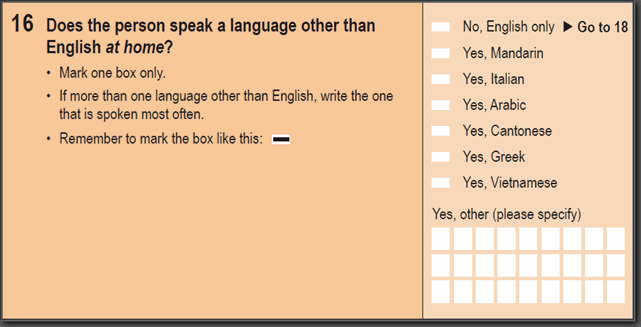Language Spoken at Home (LANP)
This variable records responses to the Census question 'Does the person speak a language other than English at home?'. It is applicable to all persons.
How this variable is created
Language Spoken at Home is coded using the Australian Standard Classification of Languages (ASCL). An image of this question is provided below.
Respondents may either use a mark box to indicate the language spoken at home or write the name of any other language in the text field. The majority of responses for Language Spoken at Home were captured automatically from the mark box response (87.9%). Written responses were coded using a combination of automatic reading and coding processes (11.2%). The remaining responses required manual coding processes when they could not be coded or derived automatically (0.9%).
If a response is not listed in the classification, it is coded to 'Inadequately described'. In 2016, 0.1% of data for Language Spoken at Home were coded to 'Inadequately described'.
In 0.9% of pre-processed data, people had either marked more than one language or had marked a language and also given a text response. In these cases, responses were accepted in the order they appeared on the form and the extra response was rejected.
A minor review of the Australian Standard Classification of Languages (ASCL) classification was conducted ahead of the 2016 Census. Changes were limited to: adding and removing languages; amending the names of some languages; and adding appropriate entries to the expanded structure and coding index. These changes were made based on 2011 Census data, research from external sources and stakeholder queries and suggestions. There were no changes to the broad level of the classification. More information on the changes is available in Australian Standard Classification of Languages (ASCL).
Variable history
A question relating to languages spoken was first asked in the 1933 Census, but not again until the 1976 Census. All censuses since then have included a similar question.
In 2016, there was minor change to the language question involving reordering the list of mark boxes. This change was a result of analysis of Language data from the 2011 Census.
Non-response rate
Item non-response rates are a measure of how many people did not respond to a particular question as a proportion of the total number of people the question was applicable to. In this instance the response is left as not stated.
The majority of item non-response is attributable to the people who did not respond to the Census at all. Refer to item non-response rates for more information. The second and smaller contributor to item non-response is when people return a Census form but may not answer a particular question(s). For more information, refer to Understanding Census data quality.
The non-response rate for this variable was 6.5% (5.1% in 2011).
Further information
A definition of Language Spoken at Home is available in the 2016 Census Dictionary.
For information related to Language Spoken at Home, see data quality statements for Proficiency in Spoken English and Proficiency in Spoken English/Language.
Household form question image
Question 16 as it appeared on the 2016 Census Household Paper Form:

Question 16 as it appeared on the 2011 Census Household Paper Form:

A text only version of the online Census Household form is available from the Downloads tab.
 Print Page
Print Page
 Print All
Print All